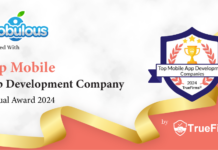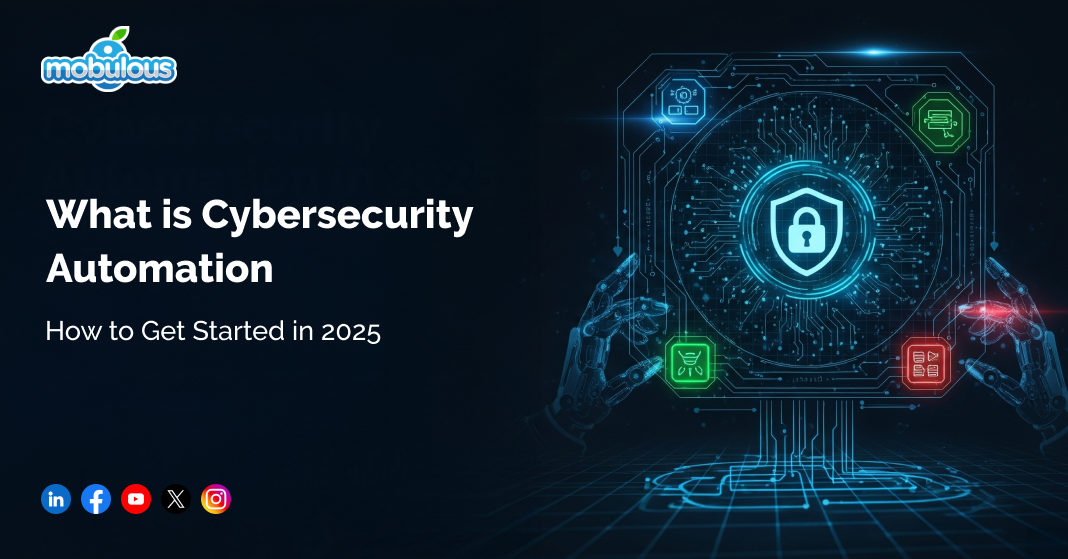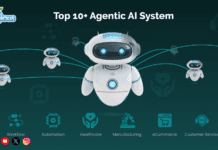What is Cybersecurity Automation?
Cybersecurity automation uses technology to perform security tasks with minimal human intervention. It makes detection, response, and risk management activities faster and more reliable. The process helps reduce the risk of human error while improving response times and consistency in protecting digital environments.
Cybersecurity automation is crucial for modern digital security, but securing your foundation is equally important. A well-built, secure website is the starting point. If you’re looking to develop a platform that integrates automation from the ground up, a professional website development company can help. They’ll ensure your digital assets are protected and ready for the future.
Benefits of Cybersecurity Automation
Cybersecurity automation brings numerous benefits that enhance detection speed, improve accuracy, and reduce costs. It also makes operations scalable and maintains compliance, making growth manageable in complex systems.
1. Faster Threat Detection and Response
Automated tools scan systems 24/7 for any signs of danger. Once a threat is found, they react quickly and sometimes even in seconds, which reduces the damage done by attackers. Faster actions also prevent the spread of malware and limit access to sensitive data.
2. Improved Accuracy and Fewer False Positives
Smart tools can filter out harmless activity and focus only on real threats, reducing false alarms that slow teams down. With better accuracy, analysts spend more time on critical issues. It leads to a more focused, efficient security operation.
3. Cost Efficiency
Automation cuts labor costs by handling repetitive tasks. Cybersecurity automation also prevents expensive data breaches. Instead of hiring more people to watch alerts, automated systems handle the load. Over time, this leads to major savings while maintaining high-level security coverage.
4. Stronger Endpoint Management
Devices are often entry points for attackers. Automation keeps all endpoints updated and patched. It enforces rules across laptops, phones, and servers. Whether users are remote or on-site, their devices remain protected and keep the entire network safer.
Businesses targeting Apple and Android users should collaborate with an experienced mobile app development company to deliver secure, high-performance apps that meet today’s compliance standards.
5. Streamlined Compliance
Regulations require logs, reports, and strict processes. Automation makes this easy as it tracks system changes, stores logs, and creates reports for audits. Businesses can meet compliance rules faster with fewer errors, which helps avoid legal trouble and improves customer trust.
6. Enhanced Scalability
Manual systems can’t grow as fast as modern businesses. Automation allows security to scale without adding staff. Whether a company adds 10 or 10,000 users, automated tools handle the load, making it easier to grow securely and without stress.
Why Cybersecurity Automation Matters in 2025
In 2025, cyber threats are growing in complexity, and manual solutions no longer suffice. Cybersecurity automation helps organizations stay secure by enabling fast, consistent, and reliable responses to emerging threats.
1. Explosion in Cyber Threats
Attackers are using advanced tools and methods. The number of threats grows yearly, and human teams can’t keep up with the pace. Automation scans for signs of trouble constantly, reacting before a person even sees the alert.
2. Need for Real-Time Responses
Time is critical during an attack, and waiting too long can lead to huge losses. Automation reacts instantly, and it can block users, shut down access, or isolate devices. This quick action limits damage and gives teams time to respond properly.
3. Reducing Human Error
Even experienced teams make mistakes like forgetting to patch or misconfiguring settings, which opens doors for hackers. Automation removes these risks as it applies patches, updates settings, and monitors changes without delay. This prevents simple errors from becoming big problems.
4. Increasing Attack Surface
More devices, apps, and cloud tools mean more places to attack. Each one is a potential weakness. Cybersecurity automation watches over all of them, manages updates, and tracks unusual behavior across the entire system to keep everything in check.
5. Freeing Up Talent for Strategy
Good security experts are hard to find, and wasting their time on basic tasks is inefficient. Automation handles routine work so experts can focus on planning, threat hunting, and training. This makes the entire team stronger and more effective.
Cyber threats have grown drastically over the years. Here are five cybersecurity facts and trends to keep in mind.
How Cybersecurity Automation Works
Cybersecurity automation uses intelligent tools that detect, analyze, and respond to threats. They use minimal human input, and systems act quickly and accurately while continuously monitoring data.
1. AI and Machine Learning Integration
These systems learn from past data spot patterns and detect unusual activity. The more they see, the smarter they get. They can tell the difference between normal traffic and something risky, leading to faster and better responses.
Smarter cybersecurity begins with automation built on intelligent systems; consider teaming up with an innovative AI/ML development company to deploy adaptive security solutions.
2. Automated Threat Detection
Automation tools monitor logs, network traffic, and files for suspicious actions. If something looks wrong, the system reacts or alerts the team and stops threats early. The goal is to prevent attacks from causing harm before they grow worse.
3. Instant Incident Response
When something bad happens, speed is everything. Automation isolates infected devices, shuts down accounts, or sends out alerts instantly and stops threats from spreading. It also gives human teams time to review and take action if needed.
4. Vulnerability Management
Automated systems scan for outdated software or missing patches. They list what needs fixing, as some tools can even patch automatically. This keeps systems safe without waiting for manual updates and also reduces risk from known vulnerabilities.
5. Security Orchestration, Automation, and Response (SOAR)
SOAR connects all security tools into one place, and it coordinates actions across systems automatically. If a threat appears, SOAR ensures the right tools and actions are used. It speeds up response and keeps things organized.
How to Get Started with Cybersecurity Automation in 2025
Starting cybersecurity automation in 2025 means understanding your needs, selecting appropriate tools, and training your team well. Begin with small steps and expand as needed.
1. Assess Your Current Security Posture
Begin by looking at what you have. Check your tools, processes, and risks, as it shows where automation will help most. It’s important to understand your weak spots and where manual work slows you down to form your automation roadmap.
2. Define Use Cases and Goals
Decide what to automate first, like picking repetitive tasks and drain time. Clear goals make tracking success easier, so start with alert filtering, patching, or user management. Simple wins build trust and show the value of automation.
3. Evaluate Tools and Providers
Not every tool fits every business, so research different platforms and try demos. Look for tools that work well with what you already use. Choosing providers without good support or strong reputations can lead to future problems.
4. Start Small and Scale Gradually
Don’t automate everything simultaneously, so start by testing and adjusting one or two workflows. Once those work, move on to others to avoid major disruptions. This reduces risks and lets teams learn as they go.
5. Invest in Skills and Certifications
Teams need the right knowledge to run automation well. Encourage training in scripting, cloud security, and specific tools. Hands-on labs and open-source projects give real experience and build confidence over time.
Understanding your development lifecycle also helps align security workflows. Here’s a detailed guide to the software development life cycle (SDLC).
6. Create a Feedback Loop
Check how cybersecurity automation performs regularly to fix errors and improve workflows. Get input from your team and users as a feedback loop ensures automation keeps working as your environment changes. It helps make the system smarter and more useful.
Challenges of Cybersecurity Automation
Cybersecurity automation is powerful, but it comes with hurdles. Address these carefully and stay aware of risks, as balance is essential.
1. Integration Complexity
Connecting new tools to old systems can be tricky as not all platforms work well together. This can lead to delays or errors, making careful planning, testing, and support essential. A messy setup can create new security risks instead of solving them.
2. Skill Shortage
Automation needs people who understand how to set it up and run it. These skills are in short supply. Without the right knowledge, tools may not work properly. Training your current team or hiring new experts is critical for success.
3. False Positives and Alert Fatigue
Automation isn’t perfect, as it may flag safe activity as a threat. Too many false alerts cause teams to ignore them, which leads to real threats being missed. Regular tuning and smart filtering help reduce this noise.
4. Over-Reliance on Technology
Automation helps, but it can’t do everything, so relying on it too much is dangerous. Human review is still important. Keep people involved in planning, reviewing, and decision-making to ensure balance and better security.
5. Cost and Resource Allocation
Good automation tools aren’t cheap, as they also need time to set up and maintain. This takes planning and a clear budget. Long-term, the savings are worth it, but be ready for an upfront investment of time and money.
Future of Cybersecurity Automation
Cybersecurity automation is evolving, and AI plays a big role, but human input remains vital. The future is about collaboration.
1. AI-Powered Real-Time Analysis
Future tools will watch real time data, learn patterns, and spot threats instantly. As attacks get faster, so will our defenses. AI will make it easier to act quickly and reduce damage before it spreads.
2. Predictive Threat Intelligence
Automation will move from reacting to predicting and warning about risks before they happen. They’ll use global data to spot new attack trends. This helps prevent threats instead of just fighting them afterward.
3. Autonomous Response Systems
Some tools will handle full responses without any human help. They’ll shut down attacks, patch systems, and alert teams on their own. This is useful when time matters most, like during fast-moving ransomware outbreaks.
4. Human-AI Collaboration
Automation won’t replace people; it will support them. Humans will handle planning and judgment, and AI will handle speed and volume. Together, they’ll create a smarter, more reliable defense system for any business.
This collaboration aligns with DevSecOps principles. Explore what DevSecOps is and why your team needs it.
5. Integration Across Ecosystems
Future automation tools will work across cloud, on-premises, and hybrid systems. They’ll connect everything from devices to servers. This creates a complete view of threats and lets teams act fast across all platforms.
Conclusion
Cybersecurity automation is vital in 2025 as threats are faster and smarter. As manual methods can’t keep pace, automation improves speed and accuracy. It supports experts and is best implemented through small, incremental steps. Train your team to use modern tools and stay updated. Combine AI and human effort together to build strong protection.
FAQs – Cybersecurity Automation
Q1. Is cybersecurity going to be automated?
Ans. Yes, cybersecurity is becoming more automated, and smart tools now handle tasks like threat detection and incident response. However, full automation isn’t likely, as cybersecurity still needs human skills like judgment, creativity, and ethics. People are essential for handling complex problems and making tough decisions.
Q2. What is an example of cybersecurity automation?
Ans. A good example of cybersecurity automation is using tools that scan systems for vulnerabilities. These tools can also fix issues or suggest what to do next, removing the need for manual checks. It saves time, reduces errors, and also helps security teams focus on more critical threats and planning.
Q3. What is AI in cybersecurity?
Ans. AI in cybersecurity means using smart systems to protect data and networks. It can analyze large amounts of data, find patterns, and detect unusual behavior. AI responds quickly to attacks, helps organizations stay ahead of threats, and strengthens system security.
Q4. Can AI replace cybersecurity?
Ans. No, AI cannot fully replace cybersecurity professionals, but it helps by doing repetitive tasks and spotting threats quickly. However, human experts are still needed to handle complex threats, set strategies, and make important decisions. AI supports the work but doesn’t replace the value of human judgment and experience.
Q5. Is cybersecurity a good future?
Ans. Yes, cybersecurity has a strong future, and the world is becoming more digital daily. As cyber threats grow, the need for skilled professionals increases. It offers many career paths and steady job growth. Cybersecurity is a smart choice for anyone looking for a stable and exciting field.
Q6. Is AI the future of cybersecurity?
Ans. Yes, AI is an important part of cybersecurity’s future as it helps detect threats faster and more accurately. AI learns from data, adapts to new attacks, and strengthens defenses over time. It works alongside humans to create faster, smarter, and more effective security systems.
































